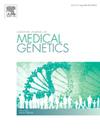Lack of behavioural improvement with sirolimus in a patient with MTOR-related macrocephaly with pigmentary mosaicism: A new case report
IF 1.7
4区 医学
Q3 GENETICS & HEREDITY
引用次数: 0
Abstract
Postzygotic activating MTOR variants result in neurocutaneous mosaic phenotypes including megalencephaly, focal cortical dysplasia, and pigmentary mosaicism (hypomelanosis of Ito), whereas germline activating variants cause Smith-Kinsgmore syndrome. The MTOR gene encodes the mechanistic target of rapamycin (mTOR), which is a core component of the PI3K-AKT-mTOR signaling pathway. As rapamycin downregulates the increased activity caused by the mosaic mTOR variant, it may result in improvement of clinical outcomes, as shown for refractory epilepsy in tuberous sclerosis, another genetic disease of the mTOR pathway. However, results of treatment have been reported in only three genotyped patients so far, one with pigmentary mosaicism, megalencephaly and epilepsy, and two with focal cortical dysplasia, with conflicting results. Here we report on a 12-year-old male patient with megalencephaly-pigmentary mosaicism and a mTOR mosaic gain-of-function variant (p.(Ser2413Ile)) in 23 % of affected skin cells, who received compassionate off-label sirolimus for severe behavioural disorder. Sirolimus was initiated at 1.3 mg twice a day with regular blood monitoring. After a 6-months period, no improvement was observed, neither on family environment-reported outcomes nor on neuropsychology scales, leading to treatment discontinuation. Despite physiopathological rationale, case reports have failed so far to suggest efficacy on the outcomes studied, which questioned the implementation of clinical trials.
西罗莫司治疗伴有色素嵌合的mtor相关性大头畸形患者行为改善不足:一个新病例报告。
合子后激活MTOR变异导致神经皮肤镶嵌表型,包括大脑畸形、局灶性皮质发育不良和色素镶嵌(伊氏低黑素症),而种系激活变异导致史密斯-金斯莫尔综合征。MTOR基因编码雷帕霉素(rapamycin, MTOR)的机制靶点,是PI3K-AKT-mTOR信号通路的核心成分。由于雷帕霉素下调马赛克mTOR变异引起的活性增加,可能导致临床结果的改善,正如mTOR途径的另一种遗传疾病结节性硬化症的难治性癫痫所显示的那样。然而,迄今为止,仅报道了3例基因型患者的治疗结果,其中1例患有色素嵌合体、大脑畸形和癫痫,2例患有局灶性皮质发育不良,结果相互矛盾。在这里,我们报告了一名12岁男性患者,23%的受影响皮肤细胞中存在巨脑-色素嵌合和mTOR嵌合功能获得变体(p.(Ser2413Ile)),他接受了同情的非标签西罗莫司治疗严重行为障碍。西罗莫司起始剂量为1.3 mg,每日2次,并定期进行血液监测。6个月后,无论是家庭环境报告的结果还是神经心理学量表,都没有观察到任何改善,导致治疗停止。尽管有生理病理原理,但到目前为止,病例报告未能表明研究结果的有效性,这对临床试验的实施提出了质疑。
本文章由计算机程序翻译,如有差异,请以英文原文为准。
求助全文
约1分钟内获得全文
求助全文
来源期刊
CiteScore
4.10
自引率
0.00%
发文量
193
审稿时长
66 days
期刊介绍:
The European Journal of Medical Genetics (EJMG) is a peer-reviewed journal that publishes articles in English on various aspects of human and medical genetics and of the genetics of experimental models.
Original clinical and experimental research articles, short clinical reports, review articles and letters to the editor are welcome on topics such as :
• Dysmorphology and syndrome delineation
• Molecular genetics and molecular cytogenetics of inherited disorders
• Clinical applications of genomics and nextgen sequencing technologies
• Syndromal cancer genetics
• Behavioral genetics
• Community genetics
• Fetal pathology and prenatal diagnosis
• Genetic counseling.

 求助内容:
求助内容: 应助结果提醒方式:
应助结果提醒方式:


